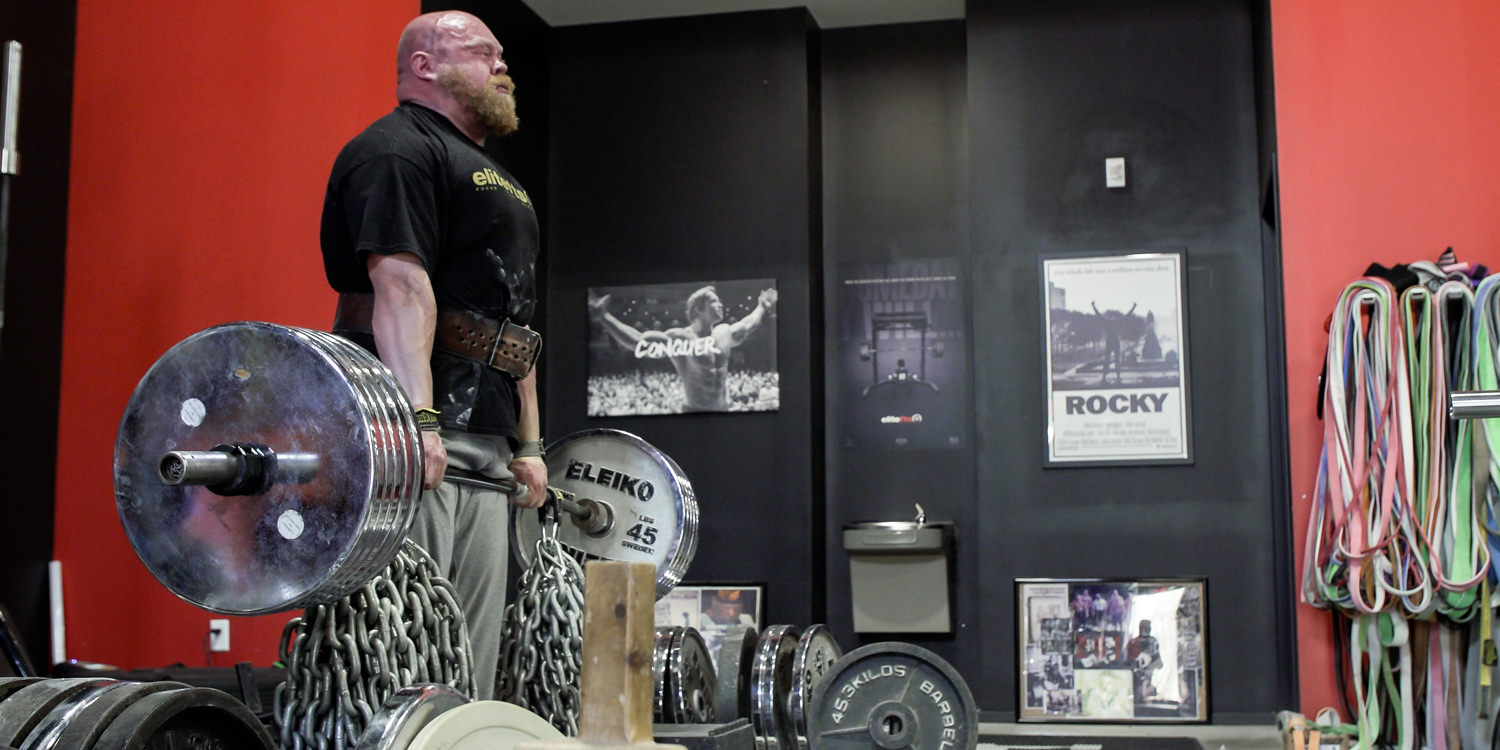
Introduction
The original and primary use of chains in resistance training is that of accommodating resistance for powerlifting. For those unaware of what specifically accommodating resistance is, here's a brief overview. Think about your range of motion for the three power lifts; squat, bench, and deadlift. Most people would describe the lockout as the strongest portion of their range of motion. Typically, the bottom portion of the range of motion is the weakest. This increase in strength throughout the range of motion is referred to as the "strength curve."
Adding chains to the bar "accommodates" the strength curve by adding resistance to the bar throughout the range of motion. When the bar is closest to the ground, the chain is mostly on the ground, applying little to no resistance. As the bar travels further from the ground, more chain will leave the ground and incrementally add weight to the bar. Chain setup and whether or not it's something you should incorporate is outside of the scope of this article.
The Benefit of Chains Aside from Accommodating Resistance
Chains provide light resistance at the bottom and heavier resistance at the top of the movement. Therefore, chains offer benefits that barbells, dumbbells, cables, and many machines can not. Unfortunately, certain exercises that provide a great stimulus for hypertrophy are more dangerous because they increase the risk of injury.
WATCH: The Evolution of Bands and Chains
Take a look at dumbbell chest flies. Flies have been a part of bodybuilding programs for decades. When I first began to lift weights, I read Arnold Schwarzenegger's Encyclopedia of Modern Bodybuilding. Of course, this was in the mid-2000s, so I relied on literature from the 70s! Anyway, dumbbell flies were the chest isolation exercise EVERYONE did after their main bench pressing work.
Many coaches and trainers are wary of incorporating dumbbell flies due to the risk of injury at the bottom stretched portion of the lift. I'd agree with this qualm. To squeeze 60-pound dumbbells at the top of the lift and feel the pecs stretch under a full range of motion, you need to hold the arms out with the same 60-pound dumbbells. Is the risk of pec tear or rotator cuff injury really worth it? Using chains as your source of weight as opposed to dumbbells will fix this problem. The next section will include demonstrations and explanations on several different uses for chains for your hypertrophy work.
Specific Exercises Utilizing Chain
Chain Flies
Substitute chains on a handle for the dumbbells. This setup removes the great stretch and replaces it with a light stretch, allowing for relatively moderate to heavy weight through the range of motion. You'll get a great contraction at the top. Again, these work best with a set of handle attachments.
Chain Skullcrushers
As a powerlifter, I'm sure you've spent a long period of time benching heavy. Maybe you start your triceps workout with skullcrushers. If so, you've probably experienced that stinging pain at the very bottom of the back of your upper arm. After years of pressing, light weight causes that pain to flare up when using straight weight on skullcrushers. I even know people who can't do them anymore because even after months of not trying them.
If this is you, trying skullcrushers with chain could be your ticket to incorporating this exercise back into your arsenal. Attach the chains to a two-handed cable attachment of your choice. It'll mimic the motion of a loaded bar yet reduce the load at the bottom of the movement. As you extend your arm and complete the rep, the weight will quickly pile on. To set up, adjust the height of your bench. Add a lighter chain to extend the length of your heavy chains. Try doing them floor-based, too.
Chain Curls
Don't waste your time maxing out the biceps. Super heavy biceps training is more of an ego boost than anything else. When a powerlifter tears their biceps, when does it most often happen? During the deadlift in the arm that is supinated in an alternating grip. The exact position your arm is in during a standard barbell curl. Where do chains fall in this rant against heavy biceps training? You can contract a fairly heavy weight without placing them in a vulnerable position.
Using various attachments, you can do supinated, neutral, and pronated curls. You can also attach a handle and do one-armed curls (as if you were using dumbbells). Below are two examples of how to approach chain curls.
Example One
Use an elitefts cambered American grip attachment. Load up a good amount of weight in a very anatomically friendly hand position. Get a heavy contraction at the top of the lift while minimizing the risk of an injury.
Example Two
The second curl demonstration is a one-armed dumbbell replacement on a preacher bench. One of the main issues with preacher curls is the intense stretch at the bottom of the range of motion. Chains eliminate that super intense stretch as a portion of the weight is resting on the ground. The specific attachment used here again from elitefts, is the grenade attachment. Having the chain go out in the direction of my thumb forces a harder contraction in the supinated position, but with the chains being on the ground at the bottom of the lift, there is a lesser chance of biceps injury.
Chain Lateral Raises
Dumbbell lateral raises rarely raise alarm for risk of injury to the deltoids. On the contrary, they can be used to increase health of the joint while stimulating hypertrophy. Doing lateral raises with chains just looks and feels cool!
Chain Bulgarian Split Squats
Bulgarian split squats' most significant complaint is the inability to go heavy. Balancing on one leg with both hands occupying dumbbells doesn't lend itself to handling heavy loads. You can hold one dumbbell and use the other hand to hold on the rack. Problem solved, right? But what if you want to be even more secure?
Enter Chain Bulgarian Split Squats.
With eight chains over your neck, you're looking at 160-pound Bulgarian split squats. They also make drop sets easy too! For those of you who are familiar with John Meadows and his Bulgarian drop set of death, bang out a set of 15-20, drop a chain or two, hit another 15-20, drop more chains, and keep hammering. Now, this technique isn't something that you should attempt every week but once in a while.
Chain Piggyback Carries and Lunges
If you've ever given a child a piggyback ride on your shoulders, you've certainly felt that substantial trap pump. Well with six-10 chains draped over your shoulders, it's like carrying a medium-sized adult on your shoulders. Attach two sets of chains with a carabiner or quick-link. This setup will help keep the chains together as they rest on your shoulders. The setup is similar to how you'd arrange them in the Bulgarian split squats. Time sets. Go the distance!
The same concept and setup can apply to walking lunges. Instead of cleaning and pressing, then lowering a barbell to your upper back, just placing the chains across your shoulders. It definitely presents an easier setup for walking lunges. If you're able to locate the same chain as it drapes on either side, grab it. It provides a nice handle to help keep you upright, almost like you're doing lunges with a safety squat bar.
Another lunge variation that is extra-friendly on those of us with beat-up knees is the rack-supported reverse lunge. As the chain weight can be entirely supported by your shoulders, your hands are free for balance. Sitting back and keeping the lower leg vertical places less of the load on the knee joint. For most people with knee pain, it can alleviate issues that may arise during lunges and other quad-dominant movements. Alternating which hand grabs the stationary support object, like a rack upright, helps keep your upper body from twisting. Don't use your arms to cheat the movement. Instead, use your arms to control the movement as you sit back.
Landmine Style Rows (T-Bar, Meadows, One-Arm Barbell)
Now using chains or even bands for pulling movements presents the OPPOSITE effect of accommodating resistance. In presses, extending movements, squats, and deadlifts, as chains leave the ground, they add more weight as your strength increases.
In pulling movements like rows, pull-ups, and pulldowns, most people are strongest at the very beginning of the pull. Creating a very small bend in the arm is much easier than pulling that last inch of the range of motion. Adding chains to a barbell row makes the hardest part of the pull even harder. So, it wouldn’t be all that beneficial. Rowing variations that use a landmine apparatus are different, though. With the weight loaded on one end of the barbell and the other end in a landmine unit or jammed into a corner, the lifter can bend over, grab the weighted end of the bar with varying grip options and row.
Some of the best examples of these rowing variations are T-Bar Rows, One-Armed Barbell Rows, and a fan-favorite, Meadow’s Rows. All of the landmine-type variations have common weight distribution; as the lifter pulls the weight off the floor, the bar becomes more upright, which has the weight redistributed through the bar and to the floor. Thus, feeling like it is getting slightly lighter throughout the range of motion.
To better illustrate this concept, imagine a barbell loaded on one end lying on the floor. Almost all of the weight will be felt at the plates near where the hands grip the bar. Imagine that same barbell with the same amount of weight on one side, but the bar is standing straight up. The weight is now being felt at the base of the barbell, opposite where your hands are. The weight at the end decreases as the bar travels closer to the upright position.
Adding chains will help you keep the load heavier as you reach the top of the range of motion. Additionally, this will allow you to stand a little more upright while doing the rows if you want to reduce the lower back pump during upper back work. Now, I am not saying that this is a superior way to do landmine-style rows. Part of the beauty of them is that they make the contraction a little bit easier, allowing for a better mind-muscle connection. If you want to keep the weight heavy throughout the movement, chains are the answer.
Conclusion
Finally, aside from the primary purpose of accommodating resistance in powerlifting and the multiple functional benefits explained in this article, chains make training fun. They can provide variation in your workouts and variation is a key component of successful programming. Variation provides a new stimulus for the body to adapt to and recover from and can prevent overuse injuries. If you have access to chains in your gym, give them a try. If you train at home, it might be worth the investment!
James Brennan has spent a decade as a biology and nutrition teacher at a public high school in New Jersey. He also served as the school’s strength and conditioning coach working with student-athletes in individual and team settings. He competes in powerlifting in the 198, 220, and 242 weight classes. Overall, his most important and enjoyable roles are husband and father.










